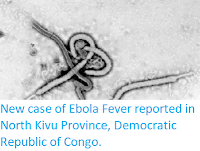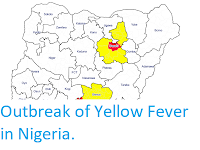The World Health Organization has reported an outbreak of Rift Valley Fever in Kenya, in Humans in Isiolo and Mandera counties and in Animals in Isiolo, Mandera, Murang’a and Garissa counties. As of 4 February 2021, there were a total of 32 human cases (14 confirmed positive), and 11 deaths (a case-fatality ratio of 34 %).
The event is believed to have started on 19 November 2020, with deaths among herders presenting with symptoms of fever, headache, general malaise with or without nausea, epistaxis/hematemesis, and abdominal pain/diarrhoea reported to the County Department of Health in Isiolo. The first Human case was reported in late November 2020 from Sericho ward in Garbatulla Subcounty. Deaths have been reported in Gafarsa and Erisaboru within Garbatulla subcounty as well Korbesa in Merti subcounty. On 16 December, Rift Valley Fever was confirmed by polymerase chain reaction at the National Virology Laboratory of the Kenya Medical Research Institute. As of 4 February 2021, a total of 22 Human cases had been reported (12 confirmed positive), and 10 deaths (three confirmed positive). Most cases were from Garbatulla subcounty, with the majority being herders, male, and aged 13 to 70 years old.
Sheep and goats were also reported sick on 19 November 2020 in Sericho subcounty, which is mainly pastoral. The communities in this area live in villages and livestock are grazed in communal grazing areas. Animal samples tested immunoglobulin M and real time polymerase chain reaction positive for Rift Valley Fever at the Central Veterinary Laboratory in Kabete and the Regional Veterinary Investigation Laboratory in Garissa. The event was officially confirmed on 7 January 2021 and reported to the World Organisation for Animal Health on 15 January 2021 and later on 22 and 29 January 2021. As of 27 January, a total of 20 livestock samples (19 Sheep and 1 Camel) had tested positive for Rift Valley Fever by immunoglobulin M-capture enzyme-linked immunosorbent assay and real-time polymerase chain reaction.
A patient from Kalmalab village, Mandera North subcounty fell ill after he was involved in the slaughter of four sick Camels. He was evacuated to a Nairobi hospital with haemorrhagic symptoms on 18 January. He was later admitted to the Intensive Care Unit with multiple organ failure. Rift Valley Fever was confirmed on 21 January at the National Virology Laboratory. He died on 22 January 2021. As of 4 February 2021, a total of 10 cases (2 confirmed Rift Valley Fever positive), including 1 death had been reported from Mandera North sub county.
Kalmalab village borders the river Dawa which broke its banks following rains in the Ethiopian highlands. The Rift Valley Fever outbreak may be associated with this flooding, as it increases the risk of Mosquito-borne zoonosis. Livestock samples have been submitted to the Central Veterinary Laboratory in Kabete for testing.
Livestock with Rift Valley Fever syndromes (including bleeding and abortions) were first reported on 29 December 2020 in Gatanga subcounty, Kihumbuini ward. The first Animal death was reported on 1 January 2021. Samples were collected from the same farm on 1 January and were confirmed Rift Valley Fever positive on 3 January at the Central Veterinary Laboratory in Kabete using enzyme-linked immunosorbent assay immunoglobulin G/immunoglobulin M testing. More suspected Animal cases have been reported in Ng’araria ward in Kandara subcounty. No Human cases have been confirmed, however suspected cases were traced and samples from affected households were collected on 25 January for testing at National Virology Laboratory.
Samples from suspected livestock (Sheep and Goats) were collected from Masalani, Ijara Subcounty and Balambala, Balambala Subcountrym on 20 December 2020 for testing and were confirmed positive for Rift Valley Fever on 22 December using enzyme-linked immunosorbent assay immunoglobulin M testing. Field investigations are ongoing to determine the extent of the outbreak.
Surveillance in livestock was initiated after the detection of the Rift Valley Fever outbreak in Isiolo. Outbreaks among Animals were observed during this time period. In December 2020, results from the Central Veterinary Laboratory in Kabete taken from 120 livestock revealed 20 (19 Sheep out of which 10 died, and 1 Camel) positive Rift Valley Fever cases confirmed by enzyme-linked immunosorbent assay immunoglobulin M testing. Further laboratory analysis are ongoing in both Human and livestock samples.
Rift Valley Fever is a Viral zoonotic disease that primarily affects Animals but also has the capacity to infect Humans. Infection can cause severe disease in both Animals and Humans. The disease also results in significant economic losses due to death and abortion among Rift Valley Fever-infected livestock.
The Rift Valley Fever Virus is a member of the Phlebovirus genus in the order Bunyavirales, of segmented negative-strand RNA Viruses, the group which also includes Hantavirus (Leprosy) and Lassa Virus (Lassa Fever).
The Rift Valley Fever Virus was first identified in 1931 during an investigation into an epidemic among sheep on a farm in the Rift Valley of Kenya. Since then, outbreaks have been reported in sub-Saharan Africa. In 1977 an explosive outbreak was reported in Egypt, the Rift Valley Fever virus was introduced to Egypt via infected livestock trade along the Nile irrigation system. In 1997–98, a major outbreak occurred in Kenya, Somalia and Tanzania following El Niño event and extensive flooding. Following infected livestock trade from the horn of Africa, Rift Valley Fever spread in September 2000 to Saudi Arabia and Yemen, marking the first reported occurrence of the disease outside the African continent and raising concerns that it could extend to other parts of Asia and Europe.
The majority of Human infections result from direct or indirect contact with the blood or organs of infected animals. The Virus can be transmitted to humans through the handling of animal tissue during slaughtering or butchering, assisting with animal births, conducting veterinary procedures, or from the disposal of carcasses or fetuses. Certain occupational groups such as herders, farmers, slaughterhouse workers, and veterinarians are therefore at higher risk of infection.
The Virus infects Humans through inoculation, for example via a wound from an infected knife or through contact with broken skin, or through inhalation of aerosols produced during the slaughter of infected Animals.
There is some evidence that humans may become infected with Rift Valley Fever by ingesting the unpasteurised or uncooked milk of infected Animals. Human infections have also resulted from the bites of infected Mosquitoes, most commonly the Aedes and Culex Mosquitoes and the transmission of Rift Valley Fever Virus by hematophagous (blood-feeding) Flies is also possible. To date, no human-to-human transmission of Rift Valley Fever has been documented, and no transmission of Rift Valley Fever to health care workers has been reported when standard infection control precautions have been put in place. There has been no evidence of outbreaks of Rift Valley Fever in urban areas.
The World Health Organisation is working closely with the Kenyan Ministry of Health via the local health cluster alongside the Food and Agriculture Organization and World Organisation for Animal Health in supporting the Rift Valley Fever outbreak investigation (determining extent of the outbreak, associated risk factors, vector surveillance, and ecology mapping), as well as the raining of health care workers, raising awareness via radio spots, printing and dissemination of information, education and communication materials, building capacity of the county laboratories to carry out tests for Rift Valley Fever and other diseases, as well as a range of other activities.
See also...








